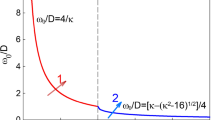Abstract
Collective chaos has been intensively investigated in globally coupled map and oscillators in which the single unit is capable of producing chaos. In this work, we study collective chaos in globally coupled phase oscillators. We consider a model with a trimodal natural frequency distribution. We find that increasing coupling strength leads to series of bifurcations such as Hopf bifurcation, saddle–node bifurcation, and period-doubling bifurcation. We observe the collective chaotic partial synchronous state, which is developed from quasiperiodic partial synchronous ones through a cascade of period-doubling bifurcations. We also explore the impacts of model parameters on the conditions producing collective chaos.






Similar content being viewed by others
References
Crawford, J.D.: Amplitude expansions for instabilities in populations of globally-coupled oscillators. J. Stat. Phys. 74, 1047–1084 (1994)
Strogatz, S.H.: From Kuramoto to Crawford: exploring the onset of synchronization in populations of coupled oscillators. Phys. D 143, 1–20 (2000)
Acebrón, J.A., Bonilla, L.L., Pérez Vicente, C.J., Ritort, F., Spigler, R.: The Kuramoto model: a simple paradigm for synchronization phenomena. Rev. Mod. Phys. 77, 137–185 (2005)
Arenas, A., Díaz-Guilera, A., Kurths, J., Moreno, Y., Zhou, C.: Synchronization in complex networks. Phys. Rep. 469, 93–153 (2008)
Shibata, T., Kaneko, K.: Collective chaos. Phys. Rev. Lett. 81, 4116–4119 (1998)
Cencini, M., Falcioni, M., Vergni, D., Vulpiani, A.: Macroscopic chaos in globally coupled maps. Phys. D 130, 58–72 (1999)
Matthews, P.C., Mirollo, R.E., Strogatz, S.H.: Dynamics of a large system of coupled nonlinear oscillators. Phys. D 52, 293–331 (1991)
Nakagawa, N., Kuramoto, Y.: Anomalous Lyapunov spectrum in globally coupled oscillators. Phys. D 80, 307–316 (1995)
Hakim, V., Rappel, W.-J.: Dynamics of the globally coupled complex Ginzburg–Landau equation. Phys. Rev. A 46, R7347–7350 (1992)
Olmi, S., Politi, A., Torcini, A.: Collective chaos in pulse-coupled neural networks. EPL 92, 60007 (2010)
Pazó, D., Montbrió, E.: From quasiperiodic partial synchronization to collective chaos in populations of inhibitory neurons with delay. Phys. Rev. Lett. 116, 238101 (2016)
So, P., Barreto, E.: Generating macroscopic chaos in a network of globally coupled phase oscillators. Chaos 21, 033127 (2011)
Komarov, M., Pikovsky, A.: Dynamics of multifrequency oscillator communities. Phys. Rev. Lett. 110, 134101 (2013)
Alonso, L.M., Mindlin, G.B.: Average dynamics of a driven set of globally coupled excitable units. Chaos 21, 023102 (2011)
Skardal, P.S., Restrepo, J.G., Ott, E.: Frequency assortativity can induce chaos in oscillator networks. Phys. Rev. E 91, 060902(R) (2015)
Hemmen, J.L.V., Wreszinski, W.F.: Lyapunov function for the Kuramoto model of nonlinearly coupled oscillators. J. Stat. Phys. 72, 145 (1993)
Ott, E., Antonsen, T.M.: Low dimensional behavior of large systems of globally coupled oscillators. Chaos 18, 037113 (2008)
Ott, E., Antonsen, T.M.: Long time evolution of phase oscillator systems. Chaos 19, 023117 (2009)
Martens, E.A., Barreto, E., Strogatz, S.H., Ott, E., So, P., Antonsen, T.M.: Exact results for the Kuramoto model with a bimodal frequency distribution. Phys. Rev. E 79, 026204 (2009)
Hong, H., Strogatz, S.H.: Kuramoto model of coupled oscillators with positive and negative coupling parameters: an example of conformist and contrarian oscillators. Phys. Rev. Lett. 106, 054102 (2011)
Ju, P., Dai, Q., Cheng, H., Yang, J.: Dynamics in the Sakaguchi-Kuramoto model with two subpopulations. Phys. Rev. E 90, 012903 (2014)
Acknowledgements
This work was supported by NSF of China under Grants Nos. 11505016, 11575036, and 71301012.
Author information
Authors and Affiliations
Corresponding author
Rights and permissions
About this article
Cite this article
Cheng, H., Guo, S., Dai, Q. et al. Collective chaos and period-doubling bifurcation in globally coupled phase oscillators. Nonlinear Dyn 89, 2273–2281 (2017). https://doi.org/10.1007/s11071-017-3585-z
Received:
Accepted:
Published:
Issue Date:
DOI: https://doi.org/10.1007/s11071-017-3585-z



